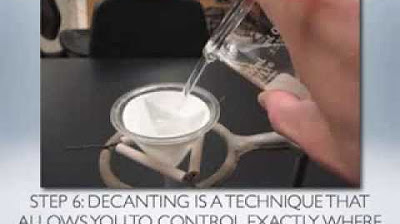Introduction to Measurements
Summary
TLDRThis video introduces measurement techniques in the Chem 10 lab experiment, covering distance, volume, mass, and temperature measurements. It demonstrates the use of tools like rulers, beakers, graduated cylinders, triple beam balances, and digital balances for tasks like estimating dimensions, measuring liquid volumes, and determining mass. The video also explains how to measure the melting point of an unknown solid using a thermometer and water bath. The experimental techniques shown will help students complete their lab reports.
Takeaways
- 📏 The video demonstrates experimental techniques and data related to measurements in chemistry.
- 📐 Measurements include distance, volume, mass, and temperature.
- 🔵 In Part A, a ruler is used to estimate the diameter of a circle and the length and width of a rectangle.
- 💧 In Part B, the volume of water in a test tube is measured using both a beaker and a graduated cylinder.
- ⚖️ In Part C, a triple beam balance and a digital balance are used to measure the mass of an empty Erlenmeyer flask.
- 📊 The electronic balance is zeroed (or tared) before measuring the mass of a beaker with and without sugar to determine the mass of the sugar.
- ❓ The ID code of an unknown solid is recorded, and a capillary tube is used for further measurement in Part B.
- 🌡️ The melting point of the unknown solid is measured by observing the melting process in a water bath.
- 🧪 A thermometer is used to estimate the temperature at which the unknown solid melts, which can help identify the substance.
- ✅ The video concludes by noting that all the experimental work needed for the report is now complete.
Q & A
What types of measurements are being made in this experiment?
-The experiment involves measurements of distance, volume, mass, and temperature.
What tools are used to measure distance in Part A of the experiment?
-A ruler is used to measure the diameter of a circle, as well as the length and width of a rectangle.
How is the volume measured in Part B of the experiment?
-Volume is measured using both a beaker and a graduated cylinder. First, water is placed in a beaker to measure the volume, and then a graduated cylinder is used for a more precise measurement.
What equipment is used to measure mass in Part C?
-A triple beam balance and a digital balance are used to measure the mass of an empty Erlenmeyer flask. A digital balance is also used to measure the mass of a beaker and sugar after tearing the balance.
What is the purpose of 'tearing' the electronic balance?
-Tearing the electronic balance means resetting it to zero, so that only the mass of the object being measured (e.g., the sugar) is recorded, excluding the weight of the container.
How is the mass of the sugar calculated in Part C?
-The mass of the sugar is calculated by first measuring the mass of the empty beaker, then adding sugar and measuring the total mass, and finally subtracting the initial mass of the beaker.
What is the purpose of the ID code of the unknown solid in Part B?
-The ID code of the unknown solid is recorded to help identify the sample later based on its melting point, which is compared to known literature values.
How is the melting point of the unknown solid determined?
-The unknown solid is placed in a capillary tube, and the temperature is monitored as the water bath is heated. When the solid melts, the temperature is recorded as its melting point.
What should be done with the recorded melting point of the unknown solid?
-The recorded melting point is compared to a list of known literature values to help identify the unknown solid.
What experimental techniques are covered in the video?
-The video covers techniques such as measuring distance using a ruler, measuring volume using a beaker and graduated cylinder, determining mass using a triple beam balance and digital balance, and determining melting points using a water bath and thermometer.
Outlines

Esta sección está disponible solo para usuarios con suscripción. Por favor, mejora tu plan para acceder a esta parte.
Mejorar ahoraMindmap

Esta sección está disponible solo para usuarios con suscripción. Por favor, mejora tu plan para acceder a esta parte.
Mejorar ahoraKeywords

Esta sección está disponible solo para usuarios con suscripción. Por favor, mejora tu plan para acceder a esta parte.
Mejorar ahoraHighlights

Esta sección está disponible solo para usuarios con suscripción. Por favor, mejora tu plan para acceder a esta parte.
Mejorar ahoraTranscripts

Esta sección está disponible solo para usuarios con suscripción. Por favor, mejora tu plan para acceder a esta parte.
Mejorar ahora5.0 / 5 (0 votes)






